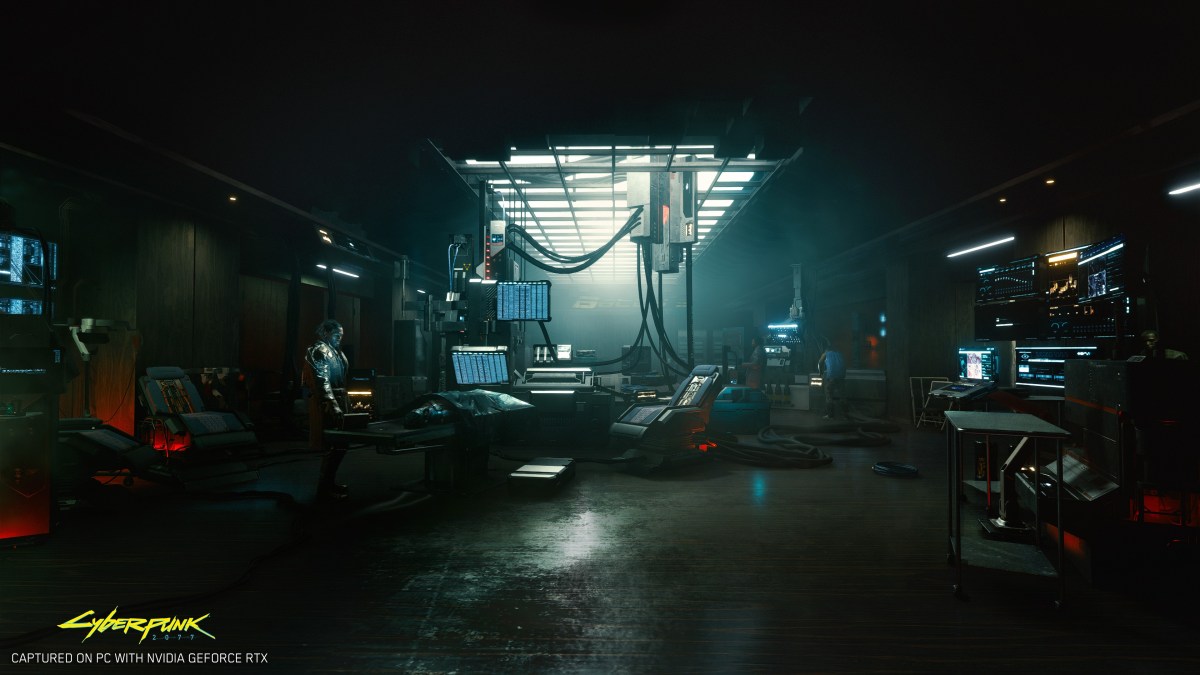Cyberpunk 2077: Revisiting the Game on an NVIDIA GeForce RTX 30 Series Laptop
Just in time for the Cyberpunk 1.21 patch update, witness the game's neon-drenched visuals at their most beautiful with NVIDIA’s RTX 30 Series laptops.

For a place that constantly reminds you how grim the future could be, Night City sure is beautiful with the right hardware. When the weather is good and you’re strolling through the Heywood District, seeing the sun glint off windows and watching the world go by, it’s almost possible to forget this is a nightmare vision of where humankind could end up. Until you notice that all the pedestrians are cybernetically augmented and it all comes flooding back.
When night time rolls in, the graphics take on a more seedy vibe. Without natural light, the world becomes drenched in the neon of cityscape where corporations have run amok. Walking down the same street feels a lot less safe, as you catch reflections from the corner of your eyes. The world still feels alive, only now it’s alive with the persistent threat of danger.
Night City Like You’ve Never Seen It Before
Of course, part of the reason why Night City looks so distractingly beautiful is the hardware I’m viewing it on. Cyberpunk 2077 is a demanding game, and it needs top PC hardware to get the most out of it. Fortunately, I’m testing the game on a state-of-the-art MSI GS66 Stealth, a gaming laptop that’s kitted out with an Intel i7 processor, 16GB RAM, a 240Hz 1440p screen, and – the cherry on an already delicious cake – an NVIDIA RTX 3080 Laptop GPU.
The NVIDIA Ampere architecture that powers GeForce RTX 30 Series laptops is what’s making my visit to Night City hold up so brilliantly. And it has a whole lot of tricks up its figurative sleeve that helps my adventures run at 60fps with 2K graphics turned up and ray tracing enabled.
Read More About NVIDIA GeForce RTX 30 Series Laptops Here
But before I get to that, a brief introduction to ray tracing for those unfamiliar. In short, it’s a cutting edge graphical advancement where every beam of light is simulated and tracked in a virtual world. That means that light, shadow, and reflections are recreated in a way never seen before for truly mesmerizing realism. In the world of Cyberpunk 2077, this initially manifests itself in the neon signs reflected in glass, water, and on the many shiny metal surfaces that occupy the game world. But it’s also present in shadows that loom eerily around corners, twisting their shape to adapt to the game’s many shifting light sources. It’s remarkably immersive.
Cyberpunk 2077 is a good looking game with a distinctive art style that’ll stay with you long after the end credits roll, and the ray tracing elevates it to a whole new level – and not always in ways that you’re actively aware of.
After all, when you’re stewing on Dexter DeShawn’s double cross or arguing with the ghost of Johnny Silverhand, you’re unlikely to be thinking of, say, the subtle shadow cast by the trinkets scattered across tables, or how the reflections on the ground shift as an advert plays on a video billboard.
The luxurious Konpeki Plaza hotel feels especially mind blowing, from the reflection of you and Jackie in the glass doors on the walk up, to the soft glow emanating from lights on the reception desk. And when you finally hit your room on the 42nd floor with the floor-to-ceiling windows, it’s such a treat to simultaneously see panoramic views of Night City and the reflection of your room’s furniture.
But with RTX disabled, the absence of these lighting effects is a constant reminder that you’re in a video game – it’s just not how light behaves in real life, and it feels instinctively wrong, even if you’re not conscious as to why.
Keeping Up Frame Rates
Stunning as ray tracing undoubtedly is, doubly impressive is the clever technology NVIDIA has working behind the scenes in order to ensure that frame rates don’t slow to a crawl. At the forefront of this is an innovative technology called DLSS – or Deep Learning Super Sampling – which uses artificial intelligence to reconstruct frames at a higher resolution. It uses advanced AI rendering to produce image quality that’s comparable to native resolution – and sometimes even better – while only conventionally rendering a fraction of the pixels.
In the wrong hands, this could be an unconvincing solution, but NVIDIA’s DLSS implementation is so seamless that you likely won’t notice a drop in image quality . Even with the sharp 2K screen of the MSI GS66 Stealth, I did notice a difference between DLSS enabled and disabled. Suffice it to say that when the action heats up, you’ll be extremely grateful for both the smoothness and stability of the RTX 30 Series GPU. The high-speed chase where you have to pick off Arasaka’s assassins as they swoop by on motorbike springs to mind. Aiming is already tricky, thanks to the speed at which Takemura is driving at, and it’d be markedly worse if your GPU let you down.
As I’m playing Cyberpunk 2077 on a gaming laptop, there’s also another invisible hand guiding the game’s smooth performance: Dynamic Boost 2.0, which automatically detects when to shift power from GPU to CPU (and vice versa) to ensure performance is as good as it can be while you’re gaming. Obviously this isn’t necessary on desktop PCs, where the PSU can draw as much power as it needs, but laptops’ fixed power and tight thermal design make this clever addition a life saver. Or a gameplay saver, at any rate.
With an NVIDIA RTX 30 Series laptop, you’re running Cyberpunk 2077 with one of the best graphics cards on the market. The oppressive dystopian atmosphere is reflected back at you from every surface, and when the action heats up, the performance won’t let you down either, with every high-intensity firefight running without distracting stutters or frame rate dips.
It’s an absolute joy to play, and frankly, I’m not looking forward to picking up my saved game on my middling desktop computer when this MSI beast returns home.
Learn more about NVIDIA’s GeForce RTX 30 Series laptops here.


